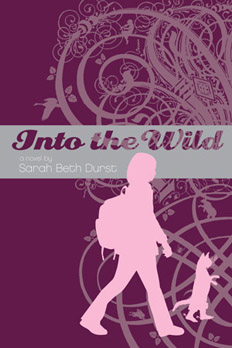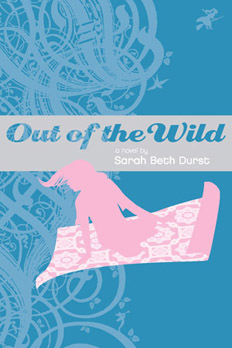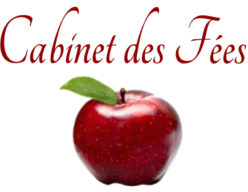Into the Wild
Out of the Wild
by Sarah Beth Durst. 2007.
Reviewed by Navah Wolfe
 In her two-book series Into the Wild and Out of the Wild, Sarah Beth Durst creates a twist on fairy tales and the time-honored tradition of “happily ever after.”
In her two-book series Into the Wild and Out of the Wild, Sarah Beth Durst creates a twist on fairy tales and the time-honored tradition of “happily ever after.”
Into the Wild introduces Julie Marchen, who lives with her mother, Zel, (formerly Rapunzel of the Tower; she now runs a hair salon) in a small Massachusetts town. Years ago, Zel led the charge to break free of the Wild’s destructive control — and she won. For the last twelve years, as fairy tale creatures learned for the first time to take control of their own lives and create their own destinies, the Wild has been residing under Julie’s bed, starved and controlled and kept to a manageable size. Julie hates it. It eats her jeans and her sneakers (and spits out tunics and seven league boots), and she’s the only kid she knows who has to babysit a dangerous plant. Besides, Julie doesn’t really believe that living in a fairy tale could be as bad as her mother remembers.
But when an errant wish sets the Wild free, Julie gets the chance to experience happily ever after firsthand. As the Wild swallows more and more of her hometown, including her mother and grandmother, Julie will need to enter the Wild to try to bring them safely home.
 In Out of the Wild, things have been going swimmingly for Julie Marchen and her mother, Zel ever since Julie managed to save her town and family from the Wild. Or, they would be, if Julie didn’t constantly feel guilty for sacrificing her father, even if it had been what it took to stop the Wild. Or if the Wild’s growth spurt hadn’t attracted lots of attention — the wrong kind — from hapless tourists who kept coming around, desperate for a look at “Northboro, Fairy Tale Capitol of the World.”
In Out of the Wild, things have been going swimmingly for Julie Marchen and her mother, Zel ever since Julie managed to save her town and family from the Wild. Or, they would be, if Julie didn’t constantly feel guilty for sacrificing her father, even if it had been what it took to stop the Wild. Or if the Wild’s growth spurt hadn’t attracted lots of attention — the wrong kind — from hapless tourists who kept coming around, desperate for a look at “Northboro, Fairy Tale Capitol of the World.”
Even though Northboro is the fairy tale capitol of the world, the fairy tale people just want to be left alone. Because as Julie learned firsthand, life in a fairy tale is not all it’s cracked up to be. The Wild is a living, thinking organism that wants to control all the pieces of the world around it, and it does so by forcing its inhabitants to live and relive and relive fairy tale events again and again and again — and when they finish their story, they have no choice but to go back to the beginning of the tale and start again.
But somebody doesn’t want the Wild to remain in the past. Someone wants to bring the Wild back, and will sacrifice everything that Julie and Zel have worked to save in order to get it.
Out of the Wild ratchets up the danger level. While it seemed very likely that the spread of the Wild in
Into the Wild was accidental, in
Out of the Wild it quickly becomes clear that this time, it is a deliberate act of sabotage — an almost magical terrorist attack. This time, it’s not haphazard — there is a mastermind at work, creating fairy tale events to feed and grow the Wild. Especially in the context of the first book, the danger feels very real and very scary.
What works best about these books is Julie. In a story about stories, Julie is a protagonist who breaks boundaries and barriers. Despite the fact that she is female, and the Wild forces girls into traditionally female — and passive — roles, Julie manages to remain an active character, a hero. And she is a fantastic hero. She’s authentically twelve, and bursting with personality. Julie is clever, brave and loyal, even when she’s aggravated. She’s an immensely likeable heroine who also feels very real. Perhaps most importantly, Julie has a foot in both the nonmagical world where she grew up and the fairy tale world of her mother, making her the perfect passport to let us in on the adventure.
Durst’s treatment of fairy tales is fascinating, and it is what makes these books stand out. She takes the Jungian concept of fairy tale archetypes, in which people (and stories) replay the same role and story again and again and again, and takes it one step further — it is not just that we are mentally trapped in the same patterns, but within the clutches of the Wild, people are physically trapped in fairy tale archetypes as well.
Durst’s real weak points are her endings. The final page of
Into the Wild falls a little flat, and feels too simple after the rich, conflicted tapestry of the rest of the novel. And it leaves me wondering if Durst knew all along that she would write a second book in this series — because even on a reread, armed with the information from
Out of the Wild, some of the characters and conclusions from
Into the Wild don’t seem to fit what they become.
And after the trauma and terror that the Wild creates,
Out of the Wild‘s ending feels far too easy. Considering that throughout the course of both books, Julie and her family are fighting against being trapped in a pat “happily ever after”, it is quite ironic that
Out of the Wild itself ends on a saccharine, happily ever after note.
That said,
Out of the Wild is a rollicking good read. Durst masterfully combines classical fairy tale images with modern moments — Cinderella’s lost shoe in Times Square, and Sleeping Beauty in the King’s house — the King of Rock and Roll, to be precise. The imagery is clever, but moreso is the overall mystery — who is behind this deliberate freeing of the Wild? The answer is unexpected, but fits perfectly into the conflicted fairy tale world that Durst has created, and is as satisfying as placing the final piece of a jigsaw puzzle.
Overall, these books are clever, entertaining fairy tale fare. Even their few faults can’t hide the fact that Sarah Beth Durst brings a compelling new angle to the fairy tale genre, and does it in a manner that will draw in readers of all ages. Younger readers will find
Into the Wild and
Out of the Wild an excellent introduction to the complexities of fairy tales, and older readers will enjoy this fresh new take on some very old ideas.
 In her two-book series Into the Wild and Out of the Wild, Sarah Beth Durst creates a twist on fairy tales and the time-honored tradition of “happily ever after.”
In her two-book series Into the Wild and Out of the Wild, Sarah Beth Durst creates a twist on fairy tales and the time-honored tradition of “happily ever after.” In Out of the Wild, things have been going swimmingly for Julie Marchen and her mother, Zel ever since Julie managed to save her town and family from the Wild. Or, they would be, if Julie didn’t constantly feel guilty for sacrificing her father, even if it had been what it took to stop the Wild. Or if the Wild’s growth spurt hadn’t attracted lots of attention — the wrong kind — from hapless tourists who kept coming around, desperate for a look at “Northboro, Fairy Tale Capitol of the World.”
In Out of the Wild, things have been going swimmingly for Julie Marchen and her mother, Zel ever since Julie managed to save her town and family from the Wild. Or, they would be, if Julie didn’t constantly feel guilty for sacrificing her father, even if it had been what it took to stop the Wild. Or if the Wild’s growth spurt hadn’t attracted lots of attention — the wrong kind — from hapless tourists who kept coming around, desperate for a look at “Northboro, Fairy Tale Capitol of the World.”
